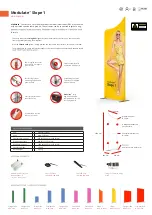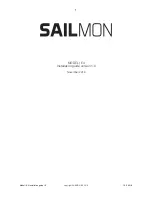
4
TO SET THE KEEL OFFSET
Put the unit into engineering mode. (This is achieved by turning off the power
supply to the unit and turning the power back on whilst the ENTER key is
depressed). The word ‘ENG’ will appear until the ENTER key is released.
Now use the up and down keys to enter the required keel offset. A long
press on the ENTER key will return to normal echo sounder operation.
SELECTING THE OPERATING UNITS (FEET OR METRES)
Put the unit into engineering mode (see above). A short press on the ENTER
key will swap the units from feet to metres. A long press on the ENTER key will
return to normal echo sounder operation.
SETTING THE SENSITIVITY THRESHOLD
Echoes received from near objects will clearly be larger than from more distant
objects. Echoes from keels or turbulence under the boat may be substantially
greater than echoes from the sea-bed and may cause the sounder to alternate
between the sea-bed and something more local. To overcome this problem, the
Cruiser sounder is fitted with variable swept gain. This reduces the sensitivity for
local objects, progressively increasing the sensitivity as depth increases. The
point at which the gain starts to rise is called the sensitivity threshold. The
sensitivity of the unit at depths below the sensitivity threshold will be
considerably reduced whilst above the sensitivity threshold the unit repidly
becomes more sensitive with increasing depth.
The sensitivity threshold is factory enter to 0.0 metres. To view the sensitivity
threshold press ENTER The value can be altered by using the up and down
keys. The value is then fixed in memory by pressing ENTER.
USING THE ALARMS
The alarm will sound if an echo is received which is shallower than the upper
alarm setting or deeper than the lower alarm setting. To view the setting of the
upper (shallow) alarm, press the up key. Return to sounder by pressing
ENTER. To view the setting of the lower (Deep) alarm, press the down key.
The setting can be altered by using the up and down keys. The new value
is entered and the unit returned to the echo sounder by pressing the ENTER
key. To enable the alarm, press the up and down keys simultaneously. A
‘bell’ symbol will appear to show the alarm is activated. When an alarm
condition is apparent the bell symbol will flash and the audible alarm will sound.
Pressing up and down keys again will disable the alarm. All parameters set
into the unit are held in memory even when the power is removed.






































